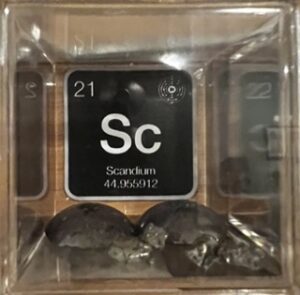Scandium
Atomic Number: 21
Atomic Mass: 44.955912 u

Scandium, a lesser-known element on the periodic table, is gaining recognition for its unique properties and growing range of applications in modern technology and industry. Symbolized as ‘Sc’ and bearing the atomic number 21, scandium is a rare earth element with characteristics that offer innovative solutions and enhancements in various fields. In this blog post, we’ll delve into the world of scandium, exploring its properties, sources, and the diverse ways it’s being utilized today.
Understanding Scandium
Scandium is a soft, silvery-white metal that exhibits many properties similar to those of the rare earth elements. It was discovered in 1879 by Swedish chemist Lars Fredrik Nilson, who named it after Scandinavia. Despite being classified as a rare earth element, scandium is relatively abundant in the Earth’s crust, but it’s rarely found in concentrated amounts, making its extraction and refinement challenging and expensive.
Key Uses of Scandium
1. Aerospace and Defense
One of the most exciting applications of scandium is in the aerospace and defense industries. When alloyed with aluminum, scandium enhances the strength, corrosion resistance, and weldability of aluminum. These scandium-aluminum alloys are used in aircraft, spacecraft, and other defense applications, where strength-to-weight ratio is critical.
2. Sports Equipment
Scandium has made a notable impact in the world of sports. Scandium-aluminum alloys are used to make high-performance sports equipment such as bicycle frames, baseball bats, and golf clubs. These alloys offer an excellent balance of strength, durability, and lightness, enhancing athletic performance.
3. Solid Oxide Fuel Cells
Scandium is a key component in solid oxide fuel cells (SOFCs), which are a type of fuel cell used for generating electricity. Scandium-stabilized zirconia is used as the electrolyte in SOFCs due to its high ionic conductivity at elevated temperatures. This application holds great potential for efficient and environmentally friendly energy generation.
4. Lighting and Electronics
In the lighting industry, scandium is used in metal halide lamps. These lamps, which contain scandium iodide, produce a bright, white light that closely resembles natural sunlight, making them ideal for television and film production, as well as stadium lighting.
5. Laser Crystals
Scandium is used in the production of laser crystals, such as scandium aluminum garnet (SAG), which are used in a variety of laser applications, including in scientific research and medical equipment.
Environmental and Economic Considerations
The rarity and difficulty in extracting scandium make it an expensive element. However, advancements in extraction and processing technologies may lead to more cost-effective production methods. Environmental considerations also play a role, as the mining and processing of scandium-bearing ores must be managed responsibly to minimize ecological impact.
Conclusion
Scandium, though not as well-known as other elements, is quietly transforming a range of industries with its unique properties. From enhancing aerospace materials to revolutionizing sports equipment and contributing to clean energy solutions, scandium’s potential is just beginning to be tapped. As technology advances, we can expect to see scandium playing an increasingly significant role in new and innovative applications, marking it as an element to watch in the coming years.
Hey kids! Have you ever heard of scandium? It’s one of the elements on the periodic table and might not be as famous as gold or silver, but it’s super interesting! Let’s discover some fun facts about scandium that will amaze you!
- A Rare Discovery: Scandium was discovered in 1879 by a Swedish chemist named Lars Fredrik Nilson. He found it while analyzing the minerals from Scandinavia, which is how scandium got its name!
- Part of a Special Group: Scandium is number 21 on the periodic table and is part of a group known as the ‘transition metals’. These metals are super cool because they can use their electrons in unique ways.
- Not So Easy to Find: Even though scandium is found everywhere in the Earth’s crust, it’s really hard to find a lot of it in one place. That makes it pretty rare and special.
- Lightweight Champion: Scandium is used to make super light but strong metals. When it’s mixed with aluminum, it creates an alloy that’s really light and strong. This is great for making things like airplanes, sports equipment, and even spacecraft!
- Helping Athletes: Because scandium can be used to make things lighter and stronger, it’s used in sports equipment like bicycle frames, baseball bats, and golf clubs. So, scandium might have helped your favorite athlete hit that home run!
- Shining Bright: Scandium is used in some special lamps that produce light that’s very similar to natural sunlight. This type of light is used in movie making and in large sports stadiums.
- A Star Connection: Just like on Earth, scandium is also found in the stars. When astronomers look at the light from stars, they can sometimes see signs of scandium.
- Super Useful in Science: In scientific research, scandium is used to make laser crystals. These crystals are important for lots of scientific experiments and in some medical equipment.
- Fancy Crystals: Some types of crystals that are used in lasers and electronic devices have scandium in them. These crystals are not only useful but also really pretty.
- The Future Looks Bright: Scientists are always finding new and exciting ways to use scandium, especially in technology and space exploration. Who knows what cool new invention will have scandium in it!
Isn’t scandium fascinating? It might not be as well-known as some other elements, but it plays a big role in making our world more advanced and fun, especially in sports and science! Keep an eye out for this amazing element around you! 🌟🚴♂️🌌
In the element box, are samples of scandium metal.
No media at this time.
 using WordPress and
using WordPress and
No responses yet